An NC State Extension Program Teaches Integration between Agriculture and Forestry
go.ncsu.edu/readext?1083291
en Español / em Português
El inglés es el idioma de control de esta página. En la medida en que haya algún conflicto entre la traducción al inglés y la traducción, el inglés prevalece.
Al hacer clic en el enlace de traducción se activa un servicio de traducción gratuito para convertir la página al español. Al igual que con cualquier traducción por Internet, la conversión no es sensible al contexto y puede que no traduzca el texto en su significado original. NC State Extension no garantiza la exactitud del texto traducido. Por favor, tenga en cuenta que algunas aplicaciones y/o servicios pueden no funcionar como se espera cuando se traducen.
Português
Inglês é o idioma de controle desta página. Na medida que haja algum conflito entre o texto original em Inglês e a tradução, o Inglês prevalece.
Ao clicar no link de tradução, um serviço gratuito de tradução será ativado para converter a página para o Português. Como em qualquer tradução pela internet, a conversão não é sensivel ao contexto e pode não ocorrer a tradução para o significado orginal. O serviço de Extensão da Carolina do Norte (NC State Extension) não garante a exatidão do texto traduzido. Por favor, observe que algumas funções ou serviços podem não funcionar como esperado após a tradução.
English
English is the controlling language of this page. To the extent there is any conflict between the English text and the translation, English controls.
Clicking on the translation link activates a free translation service to convert the page to Spanish. As with any Internet translation, the conversion is not context-sensitive and may not translate the text to its original meaning. NC State Extension does not guarantee the accuracy of the translated text. Please note that some applications and/or services may not function as expected when translated.
Collapse ▲“It is not so much for its beauty that the forest makes a claim upon men’s hearts, as for that subtle something, that quality of air, that emanation from old trees, that so wonderfully changes and renews a weary spirit.”
― Robert Louis Stevenson
Trees are among nature’s true wonders. They provide shade, habitat for birds and other wildlife, food for humans, and life-giving oxygen. They are lovely to behold. We mark the passage of time through the yearly cycle of new buds, brilliant green leaves, colorful fall foliage, and dormancy.
But for growers and gardeners, trees can go from beautiful to barrier. Their existence can stymie efforts to plant the perfect plot.
Farming With the Forest, Not Against It
“Where we live, this humid Southeast, this land wants to be forest,” Mary Bulan said. “Anybody who’s ever tried to farm has thought, ‘Whenever I turn around, there’s a new tree.’ You can feel like you’re just battling the forest out of your farm and out of your garden.”
Bulan is an NC State Extension assistant in agroforestry. She and Margaret Bloomquist, a research scholar with Extension’s North Carolina Alternative Crops and Organics Program, are based at the Mountain Horticultural Crops Research and Extension Center in Henderson County. This summer they traveled from western North Carolina to Durham County to conduct a workshop in agroforestry — to teach participants how to not only coexist with the trees on their land, but to also work with and benefit from them.
“The thing that I really love about agroforestry is that it asks, ‘What does the land want to do and how can we make that work with our own goals?’” Bulan said.
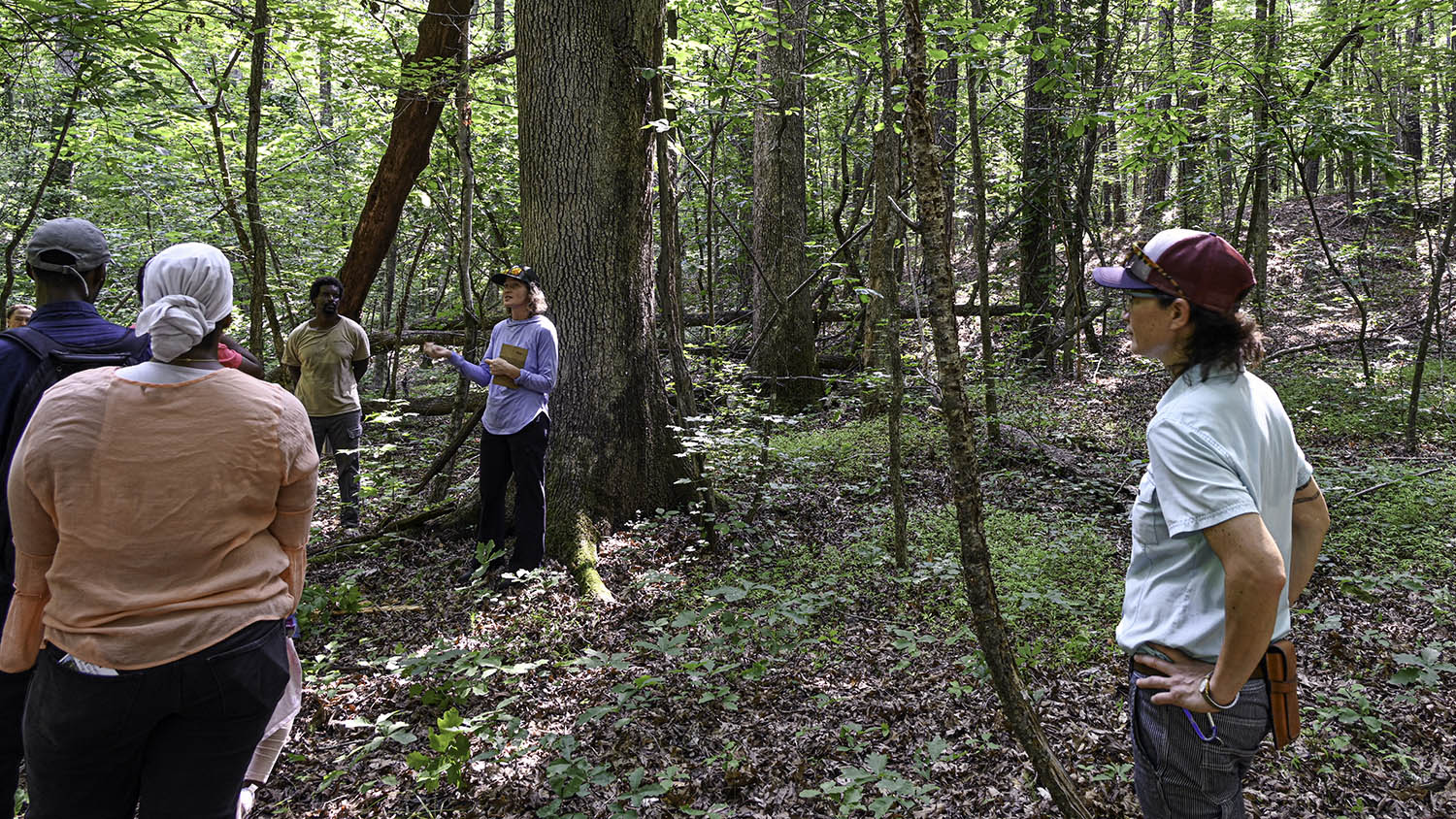
NC State Extension specialists Margaret Bloomquist (center) and Mary Bulan (right) explain the benefits of forest farming on an agroforestry farm tour in Durham.
Agroforestry is the practice of integrating trees and crops or livestock on the same land. It can include practices like alley cropping, forest farming and food forests. Its benefits include improved soil, increased livestock value, and the ability to grow diverse crops, making it an adaptable approach for many landowners and farmers.
“Agroforestry is really exciting. It can be applicable to a lot of situations,” Bloomquist said. “We’re looking at ways to interact with growing things under the canopy — what shade brings to crops, what we can grow between trees before your timber or your tree crop comes into fruition. The opportunities are sometimes short term and always longer term, when we are working with tree lifespans. We can be talking about medicinal herbs or we can be talking about sheep production, mushrooms, orchards, or pine straw.”
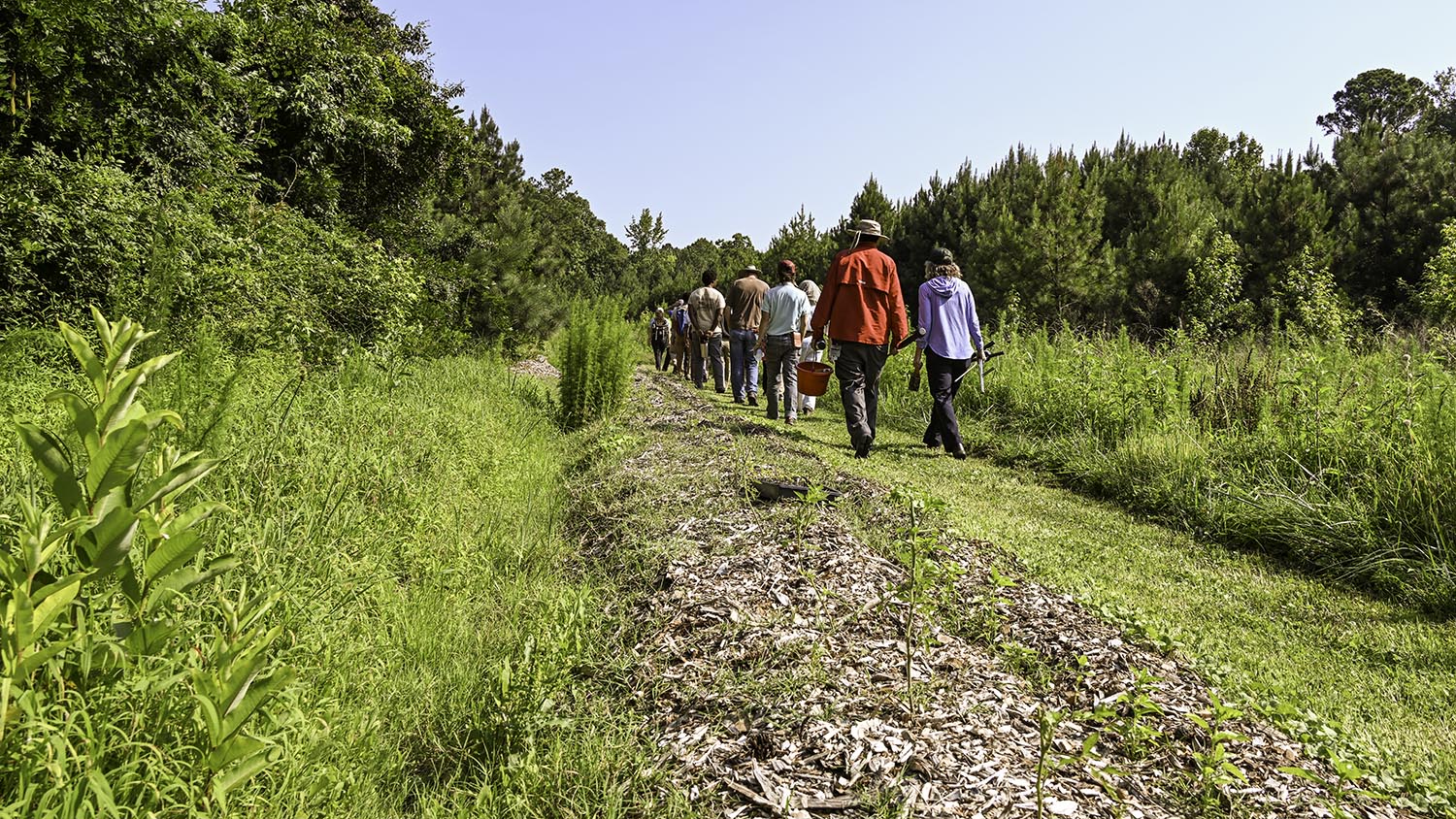
Participants in NC State Extension’s agroforestry farm tour walk past a row of crops being grown in an alley between two pine stands.
One agroforestry practice is growing crops in the alleys between rows of timber, either trees that already existed or were planted for the purpose.
“In alley cropping, we are growing at least two rows of trees and another crop in the alleys between those,” Bloomquist said. “That can be an agronomic crop, that can be a cover crop to improve soil, that can be a high-value crop like a market garden or a medicinal herb.”
A Farmer’s Trial, Error — and Transformation
Alley cropping was on display at Seed Theory Farm, a 5-acre agroforestry operation just a few miles from downtown Durham and the site of the workshop conducted by Bloomquist and Bulan. Farm owner Kaleb Karczewski grows vegetables between rows of trees for a source of revenue.
“My goal is to be as biodiverse as possible and have a little bit of food to supply to people,” Karczewski said. “I have a small CSA [Community Supported Agriculture]. We did 10 weeks in the spring and I’m prepping for 10 weeks in the fall. It’s a good little cash flow so I can keep investing back into the property.”
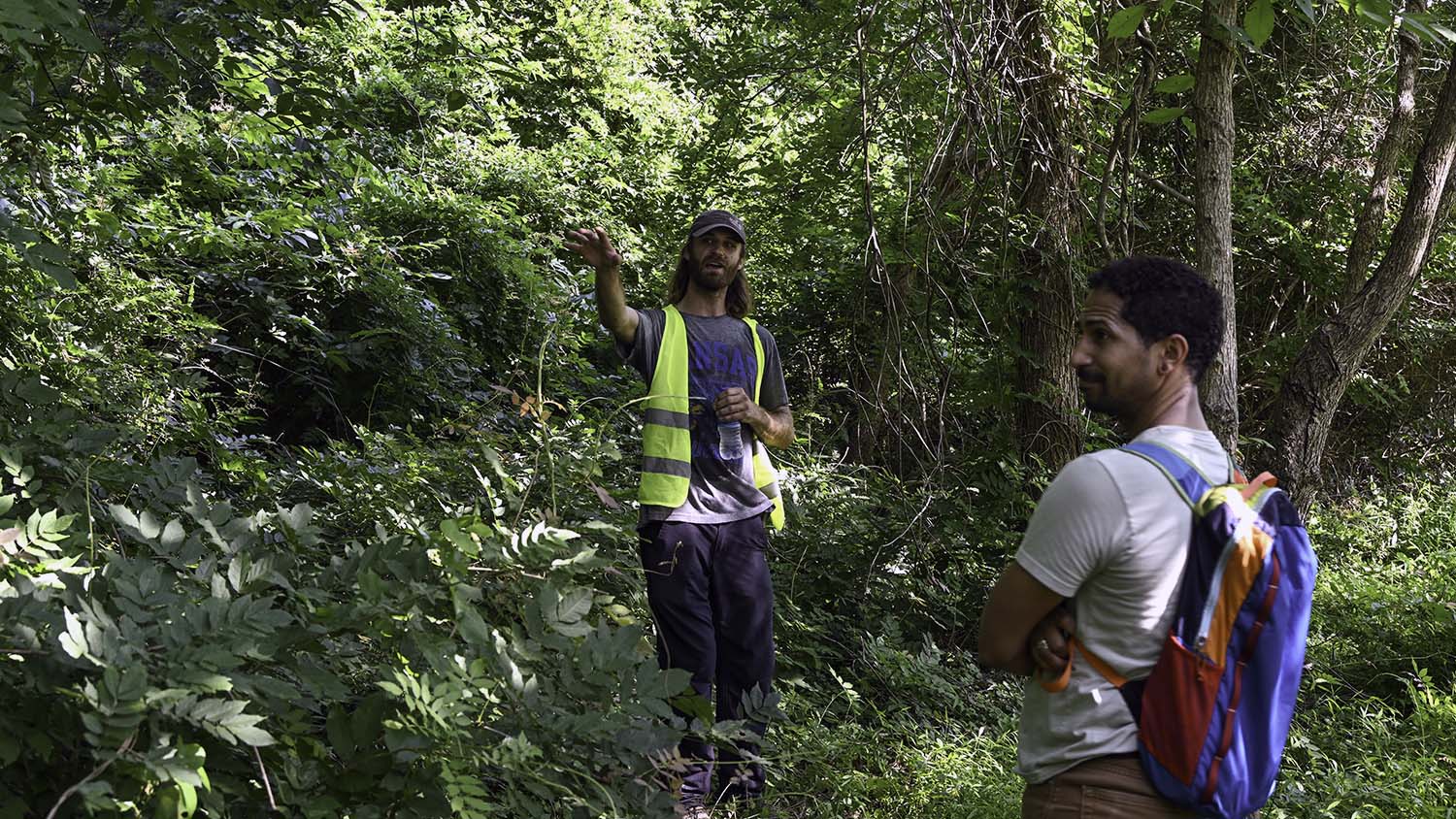
Forest farmer Kaleb Karczewski tells agroforestry tour participants about his plans for the heavily wooded part of his property in Durham.
He became more efficient when he connected with NC State Extension experts, beginning with his county office and then tapping into the specialized knowledge offered by Bloomquist and Bulan. They also introduced him to online resources, including the Appalachian Forest Farmer Coalition.
Karczewski began farming the land four years ago. His alley crop vegetables are between a couple of existing pine stands that were thinned when he purchased the property. He has planted more crops between the rows of a fruit orchard, which he installed on berms and swales that follow the land’s natural contours. He is keeping a couple of wooded acres as a nature preserve, but is exploring the possibility of planting mushrooms and berries under the canopy in a forest farming setting.
He works a couple of jobs and is out on the land whenever he has some precious hours to himself, clearing invasives like wisteria and Chinese bush clover. He’s always planning or working on his next project, whether it is installing a water catchment tank and solar pump, setting up an irrigation system, or deciding what to plant under the canopy.
“I’m a one-person operation,” he said. “I’m very, very busy outside of the farm here, but it is very much the passion project that I want to put all my energy into.”
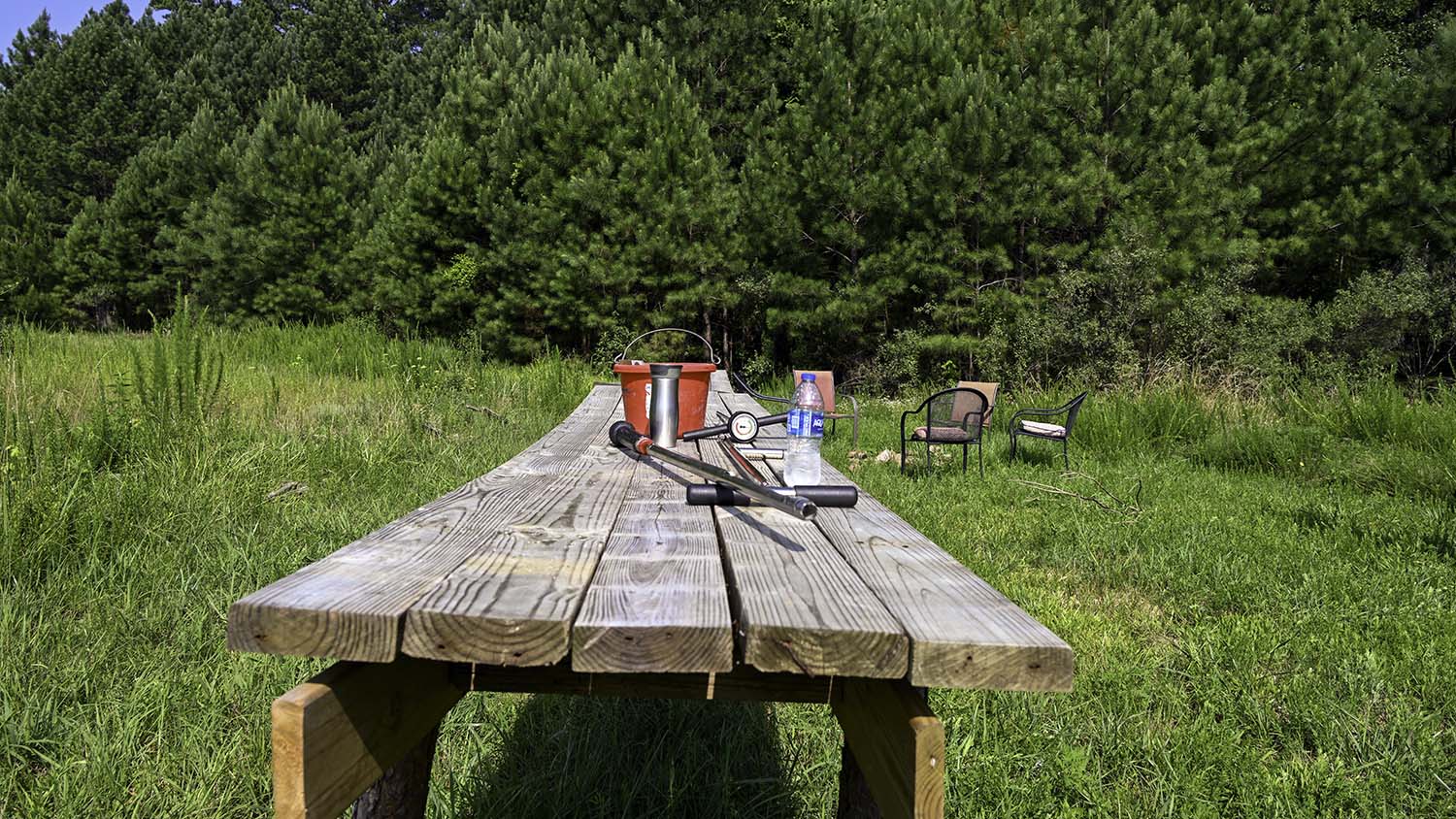
Soil testing tools on a work table at Kaleb Karczewski’s farm in Durham. Knowing the soil conditions helps growers make informed decisions on what crops to plant.
He had some plans in mind when he purchased the farm, but his early efforts were characterized by trial and error.
“It’s one thing learning something in a book. It’s a whole nother thing applying it in real life,” he said. “There’s lots of lessons to be learned out here.”
He was glad to host the farm tour, knowing the Extension personnel would also impart important information to producers and others who want to learn more about agroforestry.
“We want to expose folks that are in introductory and beginning levels of implementing some agroforestry practices on their land,” Bloomquist said. “A lot of growers and farmers learn best when they see things and they see their peers doing them.”
Spreading the Seeds of Agroforestry
The tours are also an avenue for Extension to educate natural resource professionals and technical service providers, extending the reach of agroforestry practices through a train-the-trainers model.
Related: From Researcher to Relief Specialist
“This agroforestry workshop and tour is a part of the national-reaching Catalyzing Agroforestry project,” Bloomquist said. “It is a way for farmers, service providers, and all those involved to participate in the growing Agroforestry Regional Knowledge Exchange Network (ARKx).”
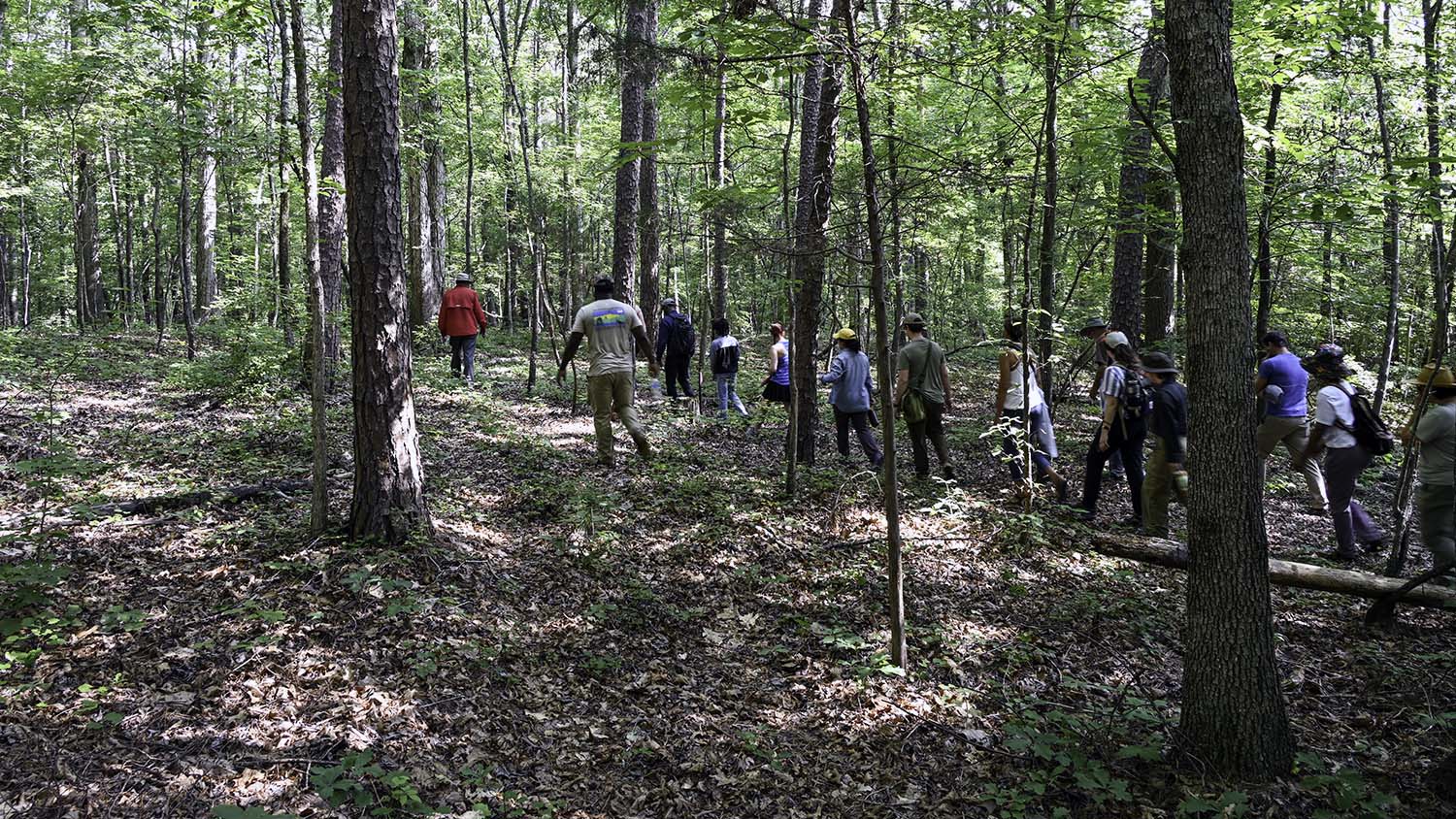
Agroforestry farm tour participants walk through the woods on Kaleb Karczewski’s Seed Theory Farm.
Vic Bolling was among those who came on the farm tour to acquire knowledge in order to pass it on.
“I work for Help for Landowners, which is a small forestry nonprofit,” he said. “We help landowners access financial and technical assistance resources in North Carolina. I am trying to learn more about agroforestry to better serve the people that I work for. And also because it’s personally something I’m really interested in.”
Larry Jared came looking for “ideas and inspiration” as he continues to transition from accountant to farmer. He owns land in northern Durham County, about 12 miles from downtown.
“I put in 40 to 50 fruit trees,” he said. “I was like, ‘Oh, I need some money in the meantime.’ I would like to move in the direction of alley cropping. I’m trying to figure out what species and what plants make sense, for both my land and the local market.”

Mushrooms can be a profitable crop in the understory of a forest farm.
Jared knew he would receive helpful information on the tour. He has learned to trust Extension’s research-based advice through other classes, including one on chicken processing and the NC State Extension Master Gardener program’s volunteer training.
“I’ve learned a lot through Extension,” he said. “Going from zero to being a farmer, Extension has been very helpful.”
In addition to seeing an example of alley cropping, he also heard that education and agritourism can be potential sources of income, and about other benefits of agroforestry.
“Many of these practices come from the ways that humans have interacted with the land and the forest for hundreds and hundreds of years,” Bloomquist said. “It encourages management, which is something I love about it. Just looking at your land with trees and saying I might try out agroforestry encourages you to develop a more holistic view of your site and your goals.”

